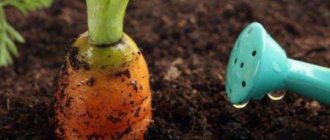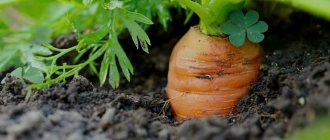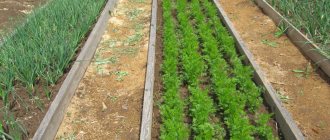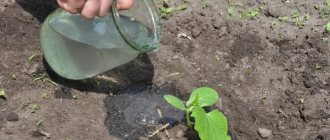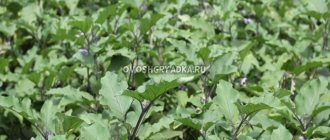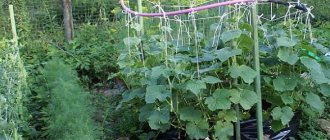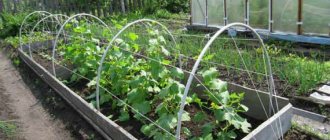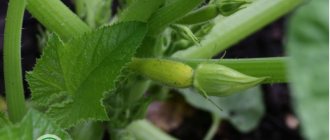In what cases and why do you need to thin carrots?
Thinning carrots helps solve a number of problems:
- increasing the free space in the beds has a beneficial effect on the size of root crops;
- thinned bushes receive more light and nutrition;
- by thinning carrots, it is possible to identify the most powerful sprouts, which will then bring the maximum yield;
- planted bushes will stop stretching upward, which will accelerate the development of roots;
- When growing thinned carrots, yield parameters increase by 50%.
This is interesting! Carrots are a champion in carotene content. According to scientific research, consuming 2.8 ml of beta-carotene per day is associated with a 40% reduction in the risk of developing cancer.
What happens after improper thinning?
Incorrect thinning of carrots is a failure to follow the technology and procedure for removing excess and weakened sprouts during the first and second thinning. Improper rooting of seedlings leads to the following consequences:
- Growing root crops are damaged and may rot.
- Unnecessary shoots appear on the roots.
- The damaged sprout weakens and then it is susceptible to various diseases.
As a result of improper thinning, you can get a “clumsy” harvest or be left without a harvest at all, which is why it is very important to ensure proper care of the sprouts in the open ground after the procedure.
Is it possible to grow carrots without thinning?
Not all gardeners want to thin out carrots. Therefore, they prefer to initially use proven methods for planting that avoid this procedure. These include the following:
- Planting granulated seeds. They are large in size. This helps to plant the seeds at the right distance and not worry about germination parameters. Such seeds are also processed by manufacturers.
- Planting using paste. To do this, the cooled substance must be mixed with grains and poured into the grooves.
- Mixing planting material with sand. You can also use peat chips or coffee grounds.
- Planting using tape. To carry out the procedure, you can use ready-made or homemade. In the second case, it is enough to glue the seeds to toilet paper.
- Planting in egg trays.
- Joint planting with radishes. Early ripening radish varieties will ripen before carrots appear. This helps to collect 2 crops from one bed.
Important! For any planting method, you should use only high-quality seeds. They must be fresh.
What is it and how is it different from weeding?
Most gardeners for planting use carrot seeds from bags that they buy in stores. Such seeds are sown thickly, as some sora do not germinate well.
It is recommended to thin out dense seedlings, as the plants will interfere with each other during growth, fighting for beneficial nutrients and microelements. Root crops will grow small, uneven, pale and not tasty.
It is important not to confuse the procedures of thinning and weeding.
- Thinning carrots is the process of periodically removing excess shoots in case of dense shoots. It is carried out to obtain smooth, large and tasty root vegetables. When breaking through seedlings, it is necessary to use special equipment.
- Weeding is the process of removing weeds that have grown mixed with carrots in the garden. You need to remove weeds with your hands so as not to harm the root crop growing nearby with the implement. The frequency of weeding depends on the growth of weeds in the garden.
How to thin carrots: thinning methods
Many gardeners are interested in how to thin out carrots. There are several methods for carrying out this procedure when growing crops in open ground.
Classic method
In this case, the roots must be thinned out manually. This method is considered not the most convenient. In addition, it can damage neighboring crops. This method does not always allow you to pull out the entire bush. In this case, the lower part will remain in the ground.
Using scissors
This method involves the use of ordinary scissors. In this case, you need to leave a distance of 4 cm between the seedlings. To carry out the procedure, you need to trim the greens at the root with scissors. At the same time, the roots themselves should remain in the ground.
However, experts do not recommend using this thinning method. Roots that remain in the soil often rot and decompose. As a result, they become sources of fungal spread throughout the entire area of the garden bed. This can lead to complete loss of the crop.
You can thin out bushes with scissors
Garden tweezers
Using garden tweezers helps to grab thinner shoots. This method is considered quite labor-intensive, since when using such a tool, extreme care must be taken so as not to damage nearby plants.
Dates
Crops are thinned out no more than twice during the entire growing season. It is recommended to carry out the procedure after the first 2 leaves appear. At this time, the normal sparseness of plantings is already visible. It is necessary to thin out in a timely manner, since during growth the roots may become intertwined. This can make it difficult for extra shoots to break through. The procedure is carried out in two stages:
- The first breaking through of seedlings is carried out 4-5 weeks after rooting of the seeds. Seedlings should be located at a distance of 1.5 - 3 centimeters from each other.
- The second - 21-28 days after the first removal of excess sprouts. During this period, weak and thickening seedlings are eliminated. You need to leave plants with 4-6 full leaves.
Is it possible to plant thinned sprouts in open ground and do they need to be replanted?
The removed sprouts can indeed be used as seedlings and transplanted to those places where seedlings rarely sprout. In this case, you should use the following recommendations:
- After thinning, the bushes should be placed in a container of water. In this case, you need to use plants that are not damaged and have strong roots.
- The tops need to be partially trimmed. As a result, its length should be 7-10 cm. This will improve the survival rate of the plant.
- When planting, the root should sink vertically into the soil. The distance between bushes should be 10 cm.
- When replanting after thinning, there is a risk that not all bushes will be accepted.
- Established carrots may produce deformed or small fruits.
Features of seeds
Almost all seeds have poor germination. After sowing, the seedlings germinate unevenly . In one part of the bed there may be a single shoot, in another there may be a strong thickening of shoots. The reasons for uneven seed germination and thickening of sprouts are the following factors:
- The seeds were sown in random order.
- Incorrect planting of seeds with deep depression.
- The appearance of a dense earthen crust on the surface of the bed after watering during planting.
Gardeners are forced to sow seeds densely due to uneven germination. As a result of such sowing, the sprouts sprout in a dense carpet. There is a need for thinning.
Advice from experienced summer residents
For the crop thinning procedure to be successful, it is important to follow some recommendations:
- It is best to remove excess plants early in the morning. This is done before the carrot flies fly to the garden bed. When the integrity of the bushes is damaged, many pests flock to the sap, which is very dangerous for the plantings.
- After removing excess plants, the soil in the growth area must be compacted tightly. This will help prevent pests from getting inside and drying out the soil near the roots of the remaining bushes.
- Carrot roots can be given to livestock. In this case, it is recommended to place the tops in a compost heap and sprinkle them with soil or sawdust. They will help to overcome the pronounced carrot aroma.
Important! When watering the beds, it is important to put a sprayer on the watering can. This helps to evenly distribute water over the planting area and avoid washing out seeds from the soil.
For watering you need to use a watering can with a sprayer.
Thinning carrots is considered an important procedure that helps increase yield parameters and make the fruits more even and beautiful. It is important to strictly follow agrotechnical recommendations.
When to perform the procedure
Carrot thinning is carried out in 2 stages. Each time the procedure is carried out at the beginning or end of the day, when the plants are wet due to dew. Choosing such a time protects the crops from the attention of the carrot fly. She is attracted by the specific aroma that disturbed plants emit. Dew or heavy watering reduces the strength of this odor.
First
The first time the carrot bed is thinned out is at the very beginning of the growing season. It is optimal to wait until the plants produce the first couple of leaves. Approximately this moment occurs 28-35 days after planting the seeds.
Second
The second stage of the thinning procedure is carried out for the final adjustment of the distance between plants. It is best to do this 21 days after the first. At this point, the carrots will have grown to 9-11 cm in height, and the small root vegetables are suitable for use as food.
Methods
Before moving on to the thinning process itself, it is necessary to determine why it is so important for these plants. As root crops grow, they need to be provided with a comfortable location in the ground.
If the bushes are concentrated too close to each other, then the carrots will be deformed and will not be able to gain the required amount even with full watering and the use of fertilizing.
It may also be useful for you to learn how to feed carrots and beets with yeast.
You can use some tricks that will save you from thinning in the future. For example, planting material can be combined with sand to evenly sow carrots. You can also mix radish and carrot seeds.
The video shows how to thin carrots:
The radishes will ripen earlier, so they can be pulled out before the carrots start to emerge. This means that there will be enough space in the garden bed for the orange root vegetable to grow fully.
It will also be interesting to learn more about how to spray carrots against carrot flies, and how to do it correctly.
Classic method
As mentioned earlier, during the entire growing season such actions must be performed 2 times. Carry out thinning for the first time as soon as the first shoots have formed. There is no need to wait long. Picking should occur when 2 leaves are formed. Before removing plants from the soil, it should be thoroughly moistened.
Then the roots will come out quickly and easily. It is also worth learning more about how to properly plant carrots in open ground, and what you should pay attention to. You can carry out the manipulation with your hands. Pull the plant straight up. This will prevent injury to neighboring shoots. Since the root system in young plants is practically absent, if handled carelessly there is a risk of branching and deformation.
When thinning, a distance of 3-4 cm must be maintained between the bushes. After manipulation, the soil should be watered with water at room temperature. Be sure to smooth out all uneven areas and loosen the soil between the rows. Excess sprouts can be discarded or placed in another bed for maximum yield.
It will be useful for all gardeners to know information about how to water carrots against weeds, and which product is the best.
The next time you should thin out the plants only when they reach a height of 10 cm. Before the procedure, moisten the soil so as not to harm the neighboring bushes.
The distance between seedlings will be 5-6 cm. But there is no need to plant adult plants in a separate bed, as they simply will not have time to take root.
When thinning carrots, you need to understand that after this procedure, essential oils of the plant are released into the air. This attracts various pests. So after removing weak growths, you need to get rid of them urgently.
But how to treat carrots from carrot flies with ammonia, and how to do it correctly, is indicated here.
Using scissors
There is a very quick way to thin carrots - using scissors.
This option is most often used by gardeners when making the first pick, when the sprouts are still too small. The essence of this method is that with the help of ordinary scissors you can trim off unnecessary seedlings and allow the remaining ones to grow fully. It is necessary to remove small and poorly developed plants. When using this thinning method, the scissors must be well sharpened.
For the best results in carrot growth, it is worth finding out whether it is possible to feed carrots with urea.
Garden tweezers
Every gardener and gardener has this tool in their arsenal. You can use tweezers to pull out carrots at any stage of picking. To do this, as usual, the soil must be well moistened.
Then take tweezers and grab the plant stem as close to the ground as possible. With a sharp movement, pull the carrot up. The disadvantage of this method is the duration of the procedure. A lot of time is spent trying to pry the desired stem with tweezers.
But how to grow a good carrot crop, and what results you can achieve on your own, is indicated here.
Thinning carrots is an important step in caring for the crop. Due to this procedure, it is possible to increase the plant’s resistance to diseases and pests, increase productivity and improve its quality. Today there are several options for performing picking, but the standard method remains preferable, during which the gardener uses his own fingers. Although it is considered the most traumatic, since you can often touch a full-fledged bush with your fingers and injure it.
Knife, bag and sleight of hand: how to quickly and effortlessly thin carrots?
Would you like me to share with you an interesting method for quickly thinning carrots?
Have you heard this joke? “Lazy people do everything quickly - because they are lazy, and with high quality - so as not to redo it.” It's about me. Well, I don’t see the point of killing ourselves in the garden beds when we can do without victims. The same applies to carrots. No matter how carefully it is planted, no matter what efforts are made, it still cannot be done without thinning, the very minimum. Well, if you want to harvest a normal harvest, of course. But leaving my strength and energy in the carrot bed somehow doesn’t make me smile at all.
Ever since my tender childhood, my dad transferred this tedious task to my sister and me, believing that “weeding is a woman’s job.” We weeded, honestly trying to carefully thin out the sprouts, but we weren’t always able to do it well - it’s hard for an adult, let alone a child! There were often “bald spots” in the garden bed, or, conversely, it was too “dense.” For this, my sister and I sometimes received punishment.
We have grown up, but the responsibility to thin out the carrots still remains with us. Recently, I began to perform this procedure differently, thanks to Aunt Nina, a neighbor in the country. Miracles, of course, do not happen and you will still need to work with your hands, but you will spend much less time on thinning, I promise you.
And effort. Try it, maybe this method will suit you.
So, what will be needed?
Table knife (with a wide tip, which is good for spreading butter on bread)
I work in knee pads, it makes things even more fun, and I wear gloves so as not to ruin my manicure. The latter is at your discretion.
What is the essence of the method?
We go to the garden when the carrots have already grown by 4-5 cm. At this time, it is already easy to distinguish strong seedlings from weak ones. We will remove them (“weaklings”).
Take a knife in one hand and collect waste in a bag with the other. Using a knife, we “dig up” unnecessary carrots, and immediately dispose of the weeded sprouts. One time! And in about 40 minutes you can “pick up” a good bed like this.
I feed the leftovers to my birds - my parrots would sell their mother for carrot tops. If you don’t have someone to feed healthy grass to, send it to the compost, it’s all good. Wish you luck!
Source of the article: https://zen.yandex.ru/media/zapisky_obyvatelnizy/noj-paket-i-lovkost-ruk-kak-bystro-i-bez-osobyh-usilii-proredit-morkov-5ec69cb6ddc21e5c0bf15de6
Rule
The verb “to thin out” contains the prefix “raz”, the root “red”, the suffix “i”, and the ending “t”. The verb “discharge” has a similar composition, with the only difference being that the root is “row” and not “ed”. The stress falls on the suffix “and”, so the root vowel in each of the words is in a weak position. The spelling of the roots of these words depends on the context of their use.
You can check a weak vowel by stress. The rule operates according to the principle of uniform spelling of the roots of words with the same root, regardless of the stressed position in the word. You need to choose a word with the same root or change the form of the word so that the emphasis falls on the dubious vowel.
The verb “thin out” is used to mean “reduce density, increase intervals, make sparser.” The vowel “e” becomes stressed in words with the same root: “rarity”, “rare”, “rare” . The verb “to thin out” is written with the vowel “e” at the root.
The verb “to discharge” is used in several meanings: “to dress up in the best clothes”, “to discharge a gun”, “to release from an electrical charge”, “to defuse a tense situation”. The vowel “I” is in a stressed position in words with the same root: “discharged”, “discharge”, “discharge”, “charge”, “dress”, “smart” . The verb “to discharge” is written with the vowel “ya” at the root.
Source of the article: https://rrepetitor.ru/check/proverochnye-slova-k-slovam-razredit-razryadit/
